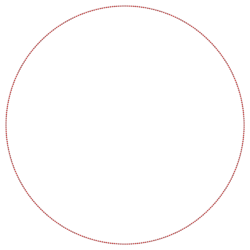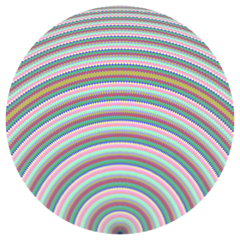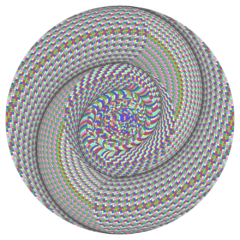360-gon
| Regular 360-gon | |
|---|---|
 A regular 360-gon | |
| Type | Regular polygon |
| Edges and vertices | 360 |
| Schläfli symbol | {360}, t{180}, tt{90}, ttt{45} |
| Coxeter diagram | |
| Symmetry group | Dihedral (D360), order 2×360 |
| Internal angle (degrees) | 179° |
| Dual polygon | Self |
| Properties | Convex, cyclic, equilateral, isogonal, isotoxal |
In geometry, a 360-gon (triacosiahexe(a)contagon) is a polygon with 360 sides. The sum of any 360-gon's interior angles is 64440 degrees.
Regular 360-gon properties
A regular 360-gon is represented by Schläfli symbol {360} and also can be constructed as a truncated 180-gon, t{180}, or a twice-truncated enneacontagon, tt{90}, or a thrice-truncated tetracontapentagon, ttt{45}.
One interior angle in a regular 360-gon is 179°, meaning that one exterior angle would be 1°.
The area of a regular 360-gon is (with t = edge length)
and its inradius is
The circumradius of a regular 120-gon is
Since 360 = 23 × 32 × 5, a regular 360-gon is not constructible using a compass and straightedge,[1] but is constructible if the use of an angle trisector is allowed.[2]
Symmetry

The regular 360-gon has Dih360 dihedral symmetry, order 720, represented by 360 lines of reflection. Dih360 has 23 dihedral subgroups: (Dih180, Dih90, Dih45), (Dih120, Dih60, Dih30, Dih15), (Dih72, Dih36, Dih18, Dih9), (Dih40, Dih20, Dih10, Dih5), (Dih24, Dih12, Dih6, Dih3), and (Dih8, Dih4, Dih2, Dih1). And 24 more cyclic symmetries: (Z360, Z180, Z90, Z45), (Z120, Z60, Z30, Z15), (Z72, Z36, Z18, Z9), (Z40, Z20, Z10, Z5), (Z24, Z12, Z6, Z3), and (Z8, Z4, Z2,Z1), with Zn representing π/n radian rotational symmetry.
These 48 symmetries are related to 66 distinct symmetries on the 360-gon. John Conway labels these lower symmetries with a letter and order of the symmetry follows the letter.[3] Full symmetry is r720 and a1 labels no symmetry. He gives d (diagonal) with mirror lines through vertices, p with mirror lines through edges (perpendicular), i with mirror lines through both vertices and edges, and g for rotational symmetry.
These lower symmetries allows degrees of freedom in defining irregular 360-gons. Only the g360 symmetry has no degrees of freedom but can seen as directed edges.
Dissection
Coxeter states that every zonogon (a 2m-gon whose opposite sides are parallel and of equal length) can be dissected into m(m-1)/2 parallelograms.[4] In particular this is true for regular polygons with evenly many sides, in which case the parallelograms are all rhombi. For the regular 360-gon, m=180, and it can be divided into 16110: 90 squares and 89 sets of 180 rhombs. This decomposition is based on a Petrie polygon projection of a 180-cube.

|

|
360-gram
A 360-gram is a 360-sided star polygon. There are 47 regular forms given by Schläfli symbols {360/7}, {360/11}, {360/13}, {360/17}, {360/19}, {360/23}, {360/29}, {360/31}, {360/37}, {360/41}, {360/43}, {360/47}, {360/49}, {360/53}, {360/59}, {360/61}, {360/67}, {360/71}, {360/73}, {360/77}, {360/79}, {360/83}, {360/89}, {360/91}, {360/97}, {360/101}, {360/103}, {360/107}, {360/109}, {360/113}, {360/119}, {360/121}, {360/127}, {360/131}, {360/133}, {360/137}, {360/139}, {360/143}, {360/149}, {360/151}, {360/157}, {360/161}, {360/163}, {360/167}, {360/169}, {360/173}, and {360/179}, as well as 132 compound star figures with the same vertex configuration. Many of the more intricate 360-grams show moiré patterns.
The regular convex and star polygons whose interior angles are some integer number of degrees are precisely those whose numbers of sides are integer divisors of 360 that are not unity, i.e. {2, 3, 4, 5, 6, 8, 9, 10, 12, 15, 18, 20, 24, 30, 36, 40, 45, 60, 72, 90, 120, 180, 360}.
References
- ↑ Constructible Polygon
- ↑ "Archived copy". Archived from the original on 2015-07-14. https://web.archive.org/web/20150714082609/http://www.math.iastate.edu/thesisarchive/MSM/EekhoffMSMSS07.pdf. Retrieved 2015-02-19.
- ↑ John H. Conway, Heidi Burgiel, Chaim Goodman-Strauss, (2008) The Symmetries of Things, ISBN:978-1-56881-220-5 (Chapter 20, Generalized Schaefli symbols, Types of symmetry of a polygon pp. 275-278)
- ↑ Coxeter, Mathematical recreations and Essays, Thirteenth edition, p.141

















































